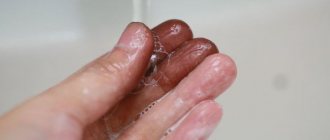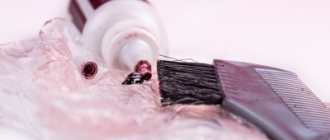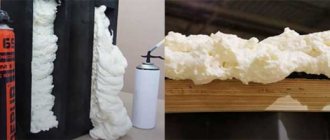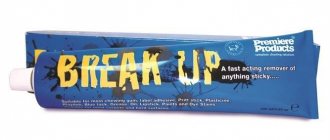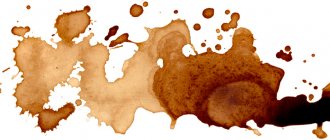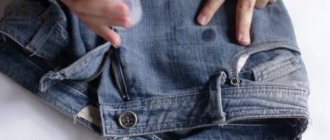The question of how to remove paint from jeans is not uncommon, because this particular clothing is considered the most convenient for repair work.
Denim items are comfortable and practical, which is why many people prefer them to work around the house. Unfortunately, such use can significantly contaminate clothing. Many stains can be washed out quite easily in the washing machine, while others, such as paint stains, make you think a little about the problem of removing them.
Removing such contaminants is not the easiest task, especially if their presence was discovered a week later. If the item is very expensive, it makes sense to entrust the cleaning procedure to professionals, otherwise you can test your own strength and try to clean the item at home.
General rules for cleaning fabric from paint
Initially, you need to note the following principles that are generally accepted in the process of treating fabric from paint stains:
- It is best to remove fresh paint that has not yet dried, so there is no need to postpone this task for a long time;
- you need to carefully choose a paint dissolving agent so as not to damage the fabric;
- You must first try the solvent on an inconspicuous part of the jeans in order to track the fabric’s reaction to it;
- It is best to apply the product inside out, so it will work faster and better and will not change the appearance of the fabric;
- to prevent streaks from occurring, you need to wipe the stain from the edges to the center;
- After cleaning the fabric with a solvent, you must wash the item using powder to remove the unpleasant aroma.
In order to solve the question of how to remove paint from jeans, you need to proceed as follows:
- Denim should be moistened with warm water and thoroughly rubbed with laundry soap.
- Now you need to brush the stained area and leave it like that for half an hour.
- If the paint begins to come off, it makes sense to soak the jeans in a soapy solution for 3-4 hours.
- If this method does not work, you can use dishwashing liquid, which is applied to the paint with a sponge without diluting with water.
- If the fabric is contaminated with oil paint, you can use butter, which, mixed with powder, is rubbed into the jeans and left in this form for 20–30 minutes.
- At the end of each stain removal method, be sure to wash your jeans in the washing machine.
In order to approach the dissolution of a paint stain from the right angle, you need to know what its composition is. Only after this can you choose a method that will show the greatest effectiveness.
The best folk methods
If the stain has penetrated deeply into the fabric, many people find it easier to throw away the damaged item. How to remove hair dye from clothes at home - you don’t need any expensive products for this purpose. The most affordable and common means that can be found in every home will help in the fight against dye.
Glycerin, salt and vinegar
The sequence of actions is simple: drop a few drops of glycerin onto the dyed area of clothing, wait 5 minutes and add a couple of drops of table vinegar, previously mixed with salt. Housewives who have tried this method personally claim that the stain disappears literally before our eyes. The final step will be regular washing and rinsing.
Important! This method is not suitable for delicate fabric, because the composition of vinegar, glycerin and salt can thin the fabric, which will lead to abrasions.
Vinegar with soda
Vinegar is the strongest opponent of dye. Thanks to the 9% acid content in its composition, this kitchen utensil can dissolve not only hair dye stains, but even stubborn rust. Moisten the affected area of clothing with vinegar and leave to soak for 30 minutes. Afterwards, thoroughly wash the product with laundry soap.
Important! Do not use apple or wine vinegar, or acetic acid. These varieties can have a detrimental effect on the condition of the tissue.
Vinegar, water and liquid soap
The painted area should be soaked in a solution of two tablespoons of white vinegar and liquid soap in a 1:1 ratio. After 15 minutes, pour 500 ml of warm water into the container. For best results, the product should be left in the solution overnight. In the morning, rinse clothes under running cold water. If necessary, the procedure can be repeated.
Chlorine bleach
This product also works well even on dried paint stains. To remove dye from clothes, you need to add a little chlorine bleach to room temperature water and thoroughly foam the solution. If the stain is large and old, then it is better to leave the item to soak overnight (unless, of course, we are talking about delicate fabric). In the morning, rinse everything thoroughly, and then wash it by hand with a generous amount of powder.
Hydrogen peroxide
The beauty of this tool is its availability and safety. Essentially, hydrogen peroxide is an oxidizing agent that effectively fights any type of stain on fabric.
To wash a hated stain from your favorite clothes, you first need to soak it in perhydrol. When the peroxide is absorbed into the fabric, after about 10 minutes, the product should be soaked in cold water for 20 minutes. After the time has passed, you can begin a thorough wash with powder and conditioner. Rub the painted area fairly vigorously, but gently, to remove the dye.
If the stain is dry, then more drastic measures must be taken. The painted area must be soaked generously with peroxide and left overnight. The perhydrol must be properly absorbed into the fibers of the fabric. In the morning, you should wipe the area with your hands and then wash it by hand.
Important! It is recommended to wash with gloves to avoid an allergic reaction that perhydrol can cause.
How to remove a fresh stain
- for this purpose, you need to use laundry soap, previously lathered on the fabric;
- The liquid that is used to wash dishes is capable of removing such contaminants quite well by dissolving them.
Solvent
The use of solvents is quite possible provided that they do not have a negative effect on the fabric:
- acetone can be applied to a cotton pad and gently cleaned denim with it (it is best to use these measures only on white or light-colored fabric);
- White spirit is able to dissolve such stains well, the only thing to consider is its pungent odor and negative effect on the hands, so it is best to scrub the fabric in the fresh air and wearing protective gloves.
Stain remover
An ordinary stain remover can cope with some paints; it is enough to use it according to the instructions so as not to spoil the product.
- If you don’t have a single suitable product at hand, you should at least wash the stain with soap and soak it in water. Only after this can you go to the nearest hardware store for a solvent or stain remover.
- When wondering how to remove dye from jeans, do not forget that it may take 3-4 attempts, which need to be methodically repeated in order to get the desired result.
Recipes for colored products
Perhaps the most difficult thing to remove hair dye from is colored clothing. I would like the material to retain all the richness and clarity of the pattern after washing. Therefore, you need to approach the choice of detergents responsibly.
Vinegar
- Apply table vinegar (9%) to the stained cloth.
- After half an hour, soak the item in cold water for five to seven minutes.
- Wash by hand or machine.
Ammonia
- Fill a basin with warm water and add two tablespoons of ammonia.
- Soak the product for ten minutes.
- Wash the item in powder and rinse several times.
Ammonia leaves a strong odor on clothes. To get rid of it, use plenty of scented conditioner.
How to remove dried paint from jeans
If you were unable to see the paint stain in time and it had time to dry, you can clean your jeans using this method:
- first you need to scrape off traces of paint from the fabric with a knife or brush;
- then place a cloth under the product and scrub the jeans with gasoline;
- after this you need to soap the stain with washing powder or soap;
- Cleaned jeans should be machine washed.
In addition, when trying to answer the question of how to remove paint from jeans, you can use this unconventional method:
- mix white clay and gasoline in equal proportions in a container;
- after the mixture is mixed until smooth, it must be thoroughly rubbed into the area of contamination;
- when the mixture dries, it must be washed off with powder.
If you cannot find white clay, you can use ordinary chalk. In this case, the solution to the problem of how to remove paint from jeans will be identical to the previous method.
It is worth noting that the problem of contaminating your favorite clothes with a paint stain may actually not be as bad as it seems at first glance. The difficulty of cleaning it will depend on the type of dye and the properties of the material. In any case, anyone can try to remove contamination from the product. However, do not forget that it is much easier to prevent a stain from appearing than to try to remove it.
Natural hair dyes: what is the difficulty of removing them?
In the production of natural hair dyes, natural dye is used. Despite the fact that 1-2 weeks are enough to completely wash this substance out of your hair, this, alas, does not apply to fabric products.
Henna
To remove the stain left after henna staining, you need to make the following solution: 40 ml of hydrogen peroxide, 40 ml of ammonia, 200 ml of cold water. Saturate the contaminated area generously with the mixture, and after 20 minutes, rinse the material thoroughly.
Important! It is worth immediately noting that this method is effective only if the stain is still fresh. If more than two days have passed since the dye got on the fabric, the item can be considered damaged.
Basma
Another dye of natural origin, used in combination with henna. Basma itself has a greenish-blue tint. To remove this bright dye from fabric, you will need such simple components as ammonia, hydrogen peroxide and water. Mix the substances in a ratio of 1/5/5, and thoroughly saturate the painted area with the solution. After half an hour, carry out an intensive hand wash.
Important! Recently, ammonia-free tinting hair balms have become popular. When using this product at home, it is recommended to wear an old jacket, since it is almost impossible to wash hair tonic from clothes. Despite the harmlessness of this dye and how quickly it is washed out of the hair, once it gets on clothes, it saturates the fibers of the fabric through and through. You can save your favorite thing, but only if you take action immediately.
The less time has passed since the paint got on your clothes, the greater the chances of saving your favorite item. However, it is not always possible to examine the stains in time, which in most cases forces you to throw away the clothes or use them for household use. Therefore, when dyeing your hair, you shouldn’t be lazy about changing your clothes once again.
Rate this post
Special means
In addition to home remedies prepared independently from available ingredients, there are special professional formulations. Before using them, you must carefully study the instructions and recommendations of the manufacturer.
The most accessible remedy is whiteness.
Each product is suitable for a specific type of fabric, some are not suitable for light or colored items.
Among the popular special tools it is worth noting:
- Bleach with chlorine. Suitable for white products. The area with the stain is moistened with cold water and bleach is applied. Leave for 30 to 60 minutes, then wash;
- A special oil designed to get rid of difficult stains. It is enough to soak the clothes in a solution to which the specified product is first added;
- Stain remover. There are various stain removers whose action is aimed at removing stains. You can apply them locally to the problematic part of the product or wash the item with the addition of the product.
The stain remover is available in gels and other forms.
Acrylic paint: composition and properties
When deciding to remove acrylic paint from a dress or trousers, you should find out what it is. It includes:
- Polymers acting as a connecting link.
- A dry pigmenting substance that gives paint a certain shade and makes it opaque.
- Diluent. This ingredient is water or an organic solvent. This component is designed to make the product less viscous.
- Various additional ingredients used to strengthen the film on the surface of a painted product, giving it a matte appearance, as well as increasing the adhesion of the coloring substance to the surface being treated.
This paint has the following properties:
- safety - it does not release toxic substances either during application or after drying;
- absence of a pungent odor characteristic of most paints and varnishes;
- water vapor permeability;
- fire and explosion resistance;
- durability;
- ease of application - the substance is well distributed over the surface to be painted either with a brush or a roller;
- ability to dry quickly - on average, a layer of this paint and varnish material dries in 30–50 minutes;
- a wide variety of colors;
- adhesion strength to the treated surface.
For cotton - ammonia, for jeans - kerosene
Whether it will be possible to remove hair and eyebrow dye stains from clothing depends on what kind of fabric we are talking about. So, methods that are effective for things made of cotton can ruin those made of nylon or neoprene.
- Cotton. It washes well with 10% ammonia (ammonia). Place the soiled item in a basin, add water and ammonia at a ratio of 10:1. It is best to carry out the procedure on the balcony, not the bathroom. Leave for three to four minutes and then wash as usual.
- Jeans. It differs in that it has a dense and complex fabric structure. This means that it is more difficult to wash, but you can use more aggressive cleaning agents. You can place gauze folded in at least four layers under the stain and saturate the area with gasoline or kerosene. Wait ten minutes and lather thickly with laundry soap, and then wash with powder.
- Nylon, nylon, silk. Fabrics are very sensitive to chemical solvents, since they themselves are produced chemically. You can get rid of hair dye stains on clothes made from such materials using regular ammonia. To do this, place a paper napkin under the stain on the front side, and wipe the back side with cotton wool or a sponge, moistened with warm ammonia. At the end of the procedure, the item is washed in a saline solution: one tablespoon of salt per liter of water.
- Wool. It deteriorates during any manipulation with aggressive detergents and cleaning substances. To get rid of stains on woolen or knitted clothes, you can try rubbing the dirty area with laundry soap, and then immersing it in boiling water for two to three minutes (but no longer - wool shrinks under the influence of high temperatures), and then wash it manually in lukewarm water using washing powder.
Some housewives believe that in war all means are good and use a full arsenal of aggressive cleaning agents against stains at the same time. Both gasoline and acetone are used mixed together. It is important to understand here that chemicals interact and, if arranged incorrectly, can ruin the texture of the fabric and color. Therefore, you can’t mindlessly mix everything. If one remedy does not help, be sure to wash the item before trying the next one.
What to do if the stain still cannot be removed?
In some cases, removing the paint seems to be an almost impossible task, and you don’t want to throw away your jeans.
And for such a problem there are also solutions, and one of them is stripes, or patches. Jeans with patches have long gained popularity and remain fashionable to this day. Such trousers always seem bright and unusual. To glue the patch you will need:
- Jeans.
- Patch (can be purchased at fabric stores or textile stores).
- Iron.
- Threads, needle.
Gluing a patch is very simple, the main thing is to calculate everything correctly. Necessary actions:
Make a mark on the jeans so that the patch lies evenly on the fabric. Also, do not forget to iron the product, as the patch must stick to a flat place. Adjust the iron temperature depending on the fabric. This information is most often found on the product label. In any case, you cannot glue the patch at the maximum temperature.
Having applied the patch to the desired location, cover it with a slightly damp cloth or gauze, and then gently iron it for 2 minutes, paying special attention to the corners of the patch. Check your patch
It should not come off when clothes are wrinkled. If you decide to glue the patch to a frequently wrinkled area, it is recommended to sew the edges of the patch with several stitches, as they may come off.
Everything just happened: ambulance
The urgency of taking action is more relevant than ever when removing stains. It is much easier to remove fresh hair dye from clothes than the one that has already become embedded in the fabric. What to do?
- If you are at home. Immediately after you notice that a stain has appeared on your blouse, immediately remove it and place it under running water. The water must be of low pressure and cool. It needs to flow down the fabric and not penetrate into it. Otherwise, there is a high risk that the dye, on the contrary, will penetrate deep into the fibers. If the “blot” is fresh, then soap or powder is not even needed.
- If you are in the salon. If a professional paints your hair in a beauty salon, you won’t be able to wash the stained item. In this case, you can use regular hairspray: it will fix the “problem” and prevent the dye from penetrating into the structure of the threads. It is sprayed generously onto the area of contamination. Afterwards, at home, the item is washed as usual. This is usually enough to solve the problem.
How can I clean different types of fabric?
To effectively get rid of a stain and not damage the item, you need to take into account the type of fabric from which it is made. Important Features:
- Cotton. If the clothes are made of durable and dense fabric, then they can be treated with chlorine bleach.
Such products can withstand washing at a temperature of 90 degrees. They can also be boiled, but only in extreme cases. The optimal washing temperature is 40 degrees. To remove stains, you can use almost any home remedies and any household chemicals.
Knitwear. This material is considered delicate.
It does not withstand friction well, so you can only remove the stain with a brush from the wrong side of the item. It is better not to use powder stain removers; preference should be given to gels and liquid detergents. The washing temperature should not exceed 40 degrees.- Jeans. The fabric is quite dense, so paint can be removed from it with both powder and liquid stain removers.
Only white items can be soaked for several hours. Colored jeans can fade and become pale if treated with aggressive compounds. The optimal washing temperature is 30-40 degrees. - Synthetics. You need to remove paint from synthetic items using liquid stain removers. You can use hydrogen peroxide, laundry soap or ammonia. The contaminated area should not be rubbed or squeezed vigorously. The optimal washing temperature is 30 degrees, but if necessary it can be increased to 60-70 degrees.
Regardless of the type of fabric, you need to familiarize yourself with the information that is on the label of each item.
